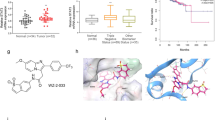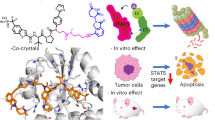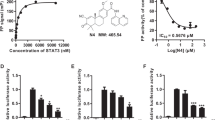Abstract
Signal transducer and activator of transcription 3 (STAT3) is constitutively activated in malignant tumors and has important roles in multiple aspects of cancer aggressiveness. Thus targeting STAT3 promises to be an attractive strategy for treatment of advanced metastatic tumors. Although many STAT3 inhibitors targeting the SH2 domain have been reported, few have moved into clinical trials. Targeting the DNA-binding domain (DBD) of STAT3, however, has been avoided due to its ‘undruggable‘ nature and potentially limited selectivity. In a previous study, we reported an improved in silico approach targeting the DBD of STAT3 that resulted in a small-molecule STAT3 inhibitor (inS3-54). Further studies, however, showed that inS3-54 has off-target effect although it is selective to STAT3 over STAT1. In this study, we describe an extensive structure and activity-guided hit optimization and mechanistic characterization effort, which led to identification of an improved lead compound (inS3-54A18) with increased specificity and pharmacological properties. InS3-54A18 not only binds directly to the DBD and inhibits the DNA-binding activity of STAT3 both in vitro and in situ but also effectively inhibits the constitutive and interleukin-6-stimulated expression of STAT3 downstream target genes. InS3-54A18 is completely soluble in an oral formulation and effectively inhibits lung xenograft tumor growth and metastasis with little adverse effect on animals. Thus inS3-54A18 may serve as a potential candidate for further development as anticancer therapeutics targeting the DBD of human STAT3 and DBD of transcription factors may not be ‘undruggable‘ as previously thought.
This is a preview of subscription content, access via your institution
Access options
Subscribe to this journal
Receive 50 print issues and online access
$259.00 per year
only $5.18 per issue
Buy this article
- Purchase on Springer Link
- Instant access to full article PDF
Prices may be subject to local taxes which are calculated during checkout







Similar content being viewed by others
References
Bromberg J, Darnell JE Jr . The role of STATs in transcriptional control and their impact on cellular function. Oncogene 2000; 19: 2468–2473.
Debnath B, Xu S, Neamati N . Small molecule inhibitors of signal transducer and activator of transcription 3 (Stat3) protein. J Med Chem 2012; 55: 6645–6668.
Lee H, Pal SK, Reckamp K, Figlin RA, Yu H . STAT3: a target to enhance antitumor immune response. Curr Top Microbiol Immunol 2011; 344: 41–59.
Chen Z, Han ZC . STAT3: a critical transcription activator in angiogenesis. Med Res Rev 2008; 28: 185–200.
Devarajan E, Huang S . STAT3 as a central regulator of tumor metastases. Curr Mol Med 2009; 9: 626–633.
Hirano T, Ishihara K, Hibi M . Roles of STAT3 in mediating the cell growth, differentiation and survival signals relayed through the IL-6 family of cytokine receptors. Oncogene 2000; 19: 2548–2556.
Dolled-Filhart M, Camp RL, Kowalski DP, Smith BL, Rimm DL . Tissue microarray analysis of signal transducers and activators of transcription 3 (Stat3) and phospho-Stat3 (Tyr705) in node-negative breast cancer shows nuclear localization is associated with a better prognosis. Clin Cancer Res 2003; 9: 594–600.
Choi CH, Song SY, Kang H, Lee YY, Kim CJ, Lee JW et al. Prognostic significance of p-STAT3 in patients with bulky cervical carcinoma undergoing neoadjuvant chemotherapy. J Obstet Gynaecol Res 2010; 36: 304–310.
Diaz N, Minton S, Cox C, Bowman T, Gritsko T, Garcia R et al. Activation of stat3 in primary tumors from high-risk breast cancer patients is associated with elevated levels of activated SRC and survivin expression. Clin Cancer Res 2006; 12: 20–28.
Bromberg JF, Wrzeszczynska MH, Devgan G, Zhao Y, Pestell RG, Albanese C et al. Stat3 as an oncogene. Cell 1999; 98: 295–303.
Chiarle R, Simmons WJ, Cai H, Dhall G, Zamo A, Raz R et al. Stat3 is required for ALK-mediated lymphomagenesis and provides a possible therapeutic target. Nat Med 2005; 11: 623–629.
Yue P, Turkson J . Targeting STAT3 in cancer: how successful are we? Expert Opin Investig Drugs 2009; 18: 45–56.
Deng J, Grande F, Neamati N . Small molecule inhibitors of Stat3 signaling pathway. Curr Cancer Drug Targets 2007; 7: 91–107.
Ren Z, Cabell LA, Schaefer TS, McMurray JS . Identification of a high-affinity phosphopeptide inhibitor of Stat3. Bioorg Med Chem Lett 2003; 13: 633–636.
Turkson J, Ryan D, Kim JS, Zhang Y, Chen Z, Haura E et al. Phosphotyrosyl peptides block Stat3-mediated DNA binding activity, gene regulation, and cell transformation. J Biol Chem 2001; 276: 45443–45455.
Turkson J, Kim JS, Zhang S, Yuan J, Huang M, Glenn M et al. Novel peptidomimetic inhibitors of signal transducer and activator of transcription 3 dimerization and biological activity. Mol Cancer Ther 2004; 3: 261–269.
Siddiquee KA, Gunning PT, Glenn M, Katt WP, Zhang S, Schrock C et al. An oxazole-based small-molecule Stat3 inhibitor modulates Stat3 stability and processing and induces antitumor cell effects. ACS Chem Biol 2007; 2: 787–798.
Schust J, Berg T . A high-throughput fluorescence polarization assay for signal transducer and activator of transcription 3. Anal Biochem 2004; 330: 114–118.
Schust J, Sperl B, Hollis A, Mayer TU, Berg T . Stattic: a small-molecule inhibitor of STAT3 activation and dimerization. Chem Biol 2006; 13: 1235–1242.
Song H, Wang R, Wang S, Lin J . A low-molecular-weight compound discovered through virtual database screening inhibits Stat3 function in breast cancer cells. Proc Natl Acad Sci USA 2005; 102: 4700–4705.
Siddiquee K, Zhang S, Guida WC, Blaskovich MA, Greedy B, Lawrence HR et al. Selective chemical probe inhibitor of Stat3, identified through structure-based virtual screening, induces antitumor activity. Proc Natl Acad Sci USA. 2007; 104: 7391–7396.
Hao W, Hu Y, Niu C, Huang X, Chang CP, Gibbons J et al. Discovery of the catechol structural moiety as a Stat3 SH2 domain inhibitor by virtual screening. Bioorg Med Chem Lett 2008; 18: 4988–4992.
Fletcher S, Singh J, Zhang X, Yue P, Page BD, Sharmeen S et al. Disruption of transcriptionally active Stat3 dimers with non-phosphorylated, salicylic acid-based small molecules: potent in vitro and tumor cell activities. Chembiochem 2009; 10: 1959–1964.
Lin L, Hutzen B, Li PK, Ball S, Zuo M, DeAngelis S et al. A novel small molecule, LLL12, inhibits STAT3 phosphorylation and activities and exhibits potent growth-suppressive activity in human cancer cells. Neoplasia 2010; 12: 39–50.
Lin L, Hutzen B, Zuo M, Ball S, Deangelis S, Foust E et al. Novel STAT3 phosphorylation inhibitors exhibit potent growth-suppressive activity in pancreatic and breast cancer cells. Cancer Res 2010; 70: 2445–2454.
Yang J, Liao X, Agarwal MK, Barnes L, Auron PE, Stark GR . Unphosphorylated STAT3 accumulates in response to IL-6 and activates transcription by binding to NFkappaB. Genes Dev 2007; 21: 1396–1408.
Timofeeva OA, Chasovskikh S, Lonskaya I, Tarasova NI, Khavrutskii L, Tarasov SG et al. Mechanisms of unphosphorylated STAT3 transcription factor binding to DNA. J Biol Chem 2012; 287: 14192–14200.
Nkansah E, Shah R, Collie GW, Parkinson GN, Palmer J, Rahman KM et al. Observation of unphosphorylated STAT3 core protein binding to target dsDNA by PEMSA and X-ray crystallography. FEBS Lett 2013; 587: 833–839.
Caboni L, Lloyd DG . Beyond the ligand-binding pocket: targeting alternate sites in nuclear receptors. Med Res Rev 2012; 33: 1081–1118.
Leung CH, Chan DS, Ma VP, Ma DL . DNA-binding small molecules as inhibitors of transcription factors. Med Res Rev 2013; 33: 823–846.
Huang W, Dong Z, Wang F, Peng H, Liu JY, Zhang JT . A small molecule compound targeting STAT3 DNA-binding domain inhibits cancer cell proliferation, migration, and invasion. ACS Chem Biol 2014; 9: 1188–1196.
Welte T, Zhang SS, Wang T, Zhang Z, Hesslein DG, Yin Z et al. STAT3 deletion during hematopoiesis causes Crohn's disease-like pathogenesis and lethality: a critical role of STAT3 in innate immunity. Proc Natl Acad Sci USA 2003; 100: 1879–1884.
Mantel C, Messina-Graham S, Moh A, Cooper S, Hangoc G, Fu XY et al. Mouse hematopoietic cell-targeted STAT3 deletion: stem/progenitor cell defects, mitochondrial dysfunction, ROS overproduction and a rapid aging-like phenotype. Blood 2012; 120: 2589–2599.
Cheng L, Pan CX, Zhang JT, Zhang S, Kinch MS, Li L et al. Loss of 14-3-3sigma in prostate cancer and its precursors. Clin Cancer Res 2004; 10: 3064–3068.
Yang Y, Liu H, Li Z, Zhao Z, Yip-Schneider M, Fan Q et al. Role of fatty acid synthase in gemcitabine and radiation resistance of pancreatic cancers. Int J Biochem Mol Biol 2011; 2: 89–98.
Acknowledgements
We thank Anthony Sinn in the In Vivo Therapeutics Core and Sheng Zhang in the Chemical Genomics Core for their technical assistance for in vivo studies and chemical synthesis, respectively. Jiayuh Lin at Ohio State University provided MDA-MB-231-STAT3 cells with the STAT3-dependent luciferase reporter while George R Stark at Cleveland Clinic provided STAT1 cDNA. This work was supported in part by the Lung Cancer Working Group at IUSCC.
Author information
Authors and Affiliations
Corresponding author
Ethics declarations
Competing interests
The authors declare no conflict of interest.
Additional information
Supplementary Information accompanies this paper on the Oncogene website
Supplementary information
Rights and permissions
About this article
Cite this article
Huang, W., Dong, Z., Chen, Y. et al. Small-molecule inhibitors targeting the DNA-binding domain of STAT3 suppress tumor growth, metastasis and STAT3 target gene expression in vivo. Oncogene 35, 783–792 (2016). https://doi.org/10.1038/onc.2015.215
Received:
Revised:
Accepted:
Published:
Issue Date:
DOI: https://doi.org/10.1038/onc.2015.215
This article is cited by
-
Unraveling the complexity of STAT3 in cancer: molecular understanding and drug discovery
Journal of Experimental & Clinical Cancer Research (2024)
-
JAKs and STATs from a Clinical Perspective: Loss-of-Function Mutations, Gain-of-Function Mutations, and Their Multidimensional Consequences
Journal of Clinical Immunology (2023)
-
Small molecule targeting FOXM1 DNA binding domain exhibits anti-tumor activity in ovarian cancer
Cell Death Discovery (2022)
-
eIF3a regulation of mTOR signaling and translational control via HuR in cellular response to DNA damage
Oncogene (2022)
-
Systemic delivery of gemcitabine analogue and STAT3 siRNA promotes antitumor immunity against melanoma
Nano Research (2022)



